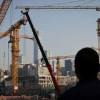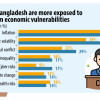Are economic growth and biodiversity compatible?

There is no time left to debate whether saving our planet is too expensive, or to keep promoting socioeconomic models that are clearly not working.
We are witnessing a planetary biodiversity crisis, with species being lost at an unprecedented rate in modern times. At the same time, global economic growth – as measured by gross domestic product – is still increasing and forecast to continue. This is because economic growth is considered "mandatory" to eradicate poverty.
Major biodiversity-related treaties and international agreements promote the narrative of economic growth as necessary, implying that more efficiency in the use of resources can enable economic growth without affecting ecosystems and biodiversity.
This is clearly not the case. Increased polluting emissions in water, air and soil, land-use change, climate change and the spread of invasive species – the major drivers of biodiversity loss – are all "by-products" of economic growth.
We have found ourselves in an apparently inextricable dilemma: economic growth is needed to overcome poverty and achieve prosperity targets. That same growth is responsible for potentially irreparable damage to biodiversity and to the "ecosystem services" (such as pollination for crops, or pest control for example) it provides to humanity. These are indispensable ingredients for economic growth.
The potential result: the global economy will keep growing until a tipping point where biodiversity will collapse, and there will be no economy on a dead planet.
There is no complete solution to this dilemma. The right pathway may be rethinking our global socioeconomic model, and this will take time, effort, and sacrifice.
However, there are a few urgent steps in the right direction that need to be considered. These include:
Rethinking how we measure wealth and economic prosperity. There is a general global consensus that focusing on GDP is not adequate to bring the world out of the climate and biodiversity crisis, but this index is still mainstreamed in press articles, political promises, and non-specialist public perception.
New generations of economists and media professionals need to promote other indices of wealth, that include natural and social capital, such as the Green GDP, the Human Development Index (HDI), the Index of Sustainable Economic Welfare (ISEW) and the Genuine Progress Indicator (GPI), for example.
Giving monetary value to biodiversity and nature is controversial, and not the final solution to the extinction crisis. A market failure in this case would have dramatic consequences, and how do we ensure that the price given to cultural values or biodiversity is right?
Valuation of nature can be a useful tool and a starting point for finding common ground in policy discussions around natural capital, nature conservation and development goals. Probably we cannot – and likely we do not want to - assign a price tag to a forest, a coral reef, or a healthy river, but we can evaluate the direct benefits that these ecosystems provide to us, so we can take them into account in financial analysis of strategies and development projects.
Economic growth is a tool to achieve global sustainability goals, and not the final goal itself. Environmental and well-being policies need to be supported regardless on their impact on GDP.
Restricting biodiversity or nature-positive policies only to those compatible with GDP growth is not sustainable in the long term. For example, small-scale fisheries are less productive than industrial fishing in terms of GDP growth, but offer higher social and economic value for local communities.
Taxation and public subsidies matter for the environment. Perverse negative subsidies to otherwise uneconomical activities (such as long-distance fishing) need to be restructured toward local agroeconomic development.
Market-based instruments for environmental management, such as carbon taxes, extended producer responsibility (for example for plastic packaging production), and the polluter-pays principle can help to reduce emissions of harmful pollutants.
Protected natural areas need to be considered a proper investment and not a concession to "green" political pressure. Protected areas – especially if we look beyond pure monetary terms – have a significant return on investment, even greater if they are interconnected.
In the upcoming Convention for Biological Diversity (CBD) COP in Montreal, Canada, delegates will discuss to a proposed increase of global protected area goals to 30 per cent of each countries land and sea area. As for the Paris Agreement on GHG emissions, these targets will be achievable only if they will be adequately funded.
Nature-positive investments are achieving both an economic return and an improvement of natural capital. Regenerative farming can achieve the same crop yield and steady incomes while helping protect and enhance biodiversity. This also enhances critical ecosystem services as pollination and pest control, while decreasing the costs in a virtuous positive feedback loop.
As we are witnessing almost daily, the climate and biodiversity crises are inextricably linked and affect all of us, especially the most vulnerable. There is no time left to debate whether saving our planet is too expensive, or to keep promoting socioeconomic models that are clearly not working. Maybe the first step is to move away from GDP as the main economic growth reference.
The author is senior environment specialist, sustainable development and climate change department of the Asian Development Bank.

 For all latest news, follow The Daily Star's Google News channel.
For all latest news, follow The Daily Star's Google News channel. 








Comments